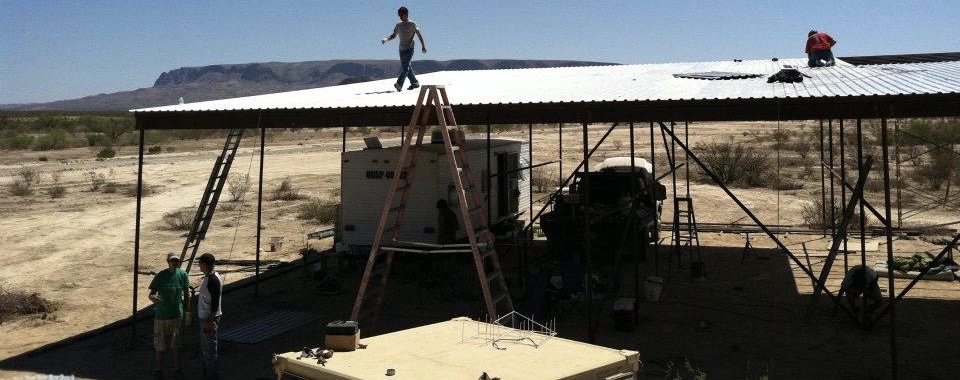Harvesting passive condensation—dew-harvesting roof in west Texas
Near Study Butte, West Texas, USA.
Latitude 29˚ 19’N.
Elevation: 2674 feet (815 meters).
Average annual rainfall 11.6 inches per year.
Average annual humidity 77%.
Harvesting passive condensation
Passive condensation occurs on naturally cool surfaces (surfaces cooler than the air temperature)—no generated power such as electricity is needed to cool the surface on which the atmospheric water (moisture in the air) condenses.
Passive dew-harvesting roof in West Texas
Katherine and Markus Ottmers of Ottmers Agricultural Technologies near Study Butte, West Texas built a shed-style 50’ by 50’ foot (15 by 15 m) metal roof that can harvest up to 74 gallons of dew—atmospheric moisture passively condensing on, then running off their roof—on a humid morning.1
That’s significant considering the area’s low rainfall (average annual rainfall is only 11.6 inches per year, though average annual humidity is 77%).

In Tucson, Arizona (11 inches of average annual rainfall) on humid mornings I too find dew passively condenses on my metal roof, much like water condenses on the outside of a glass of iced tea. Just before, and as, the sun rises and warms the air, the metal roof (that cooled off at night) is cooler than the air temperature, so moisture in the warmer air then condenses on the cooler roof. Sections of roof sloping away from the morning sun, stay shaded and cooler longer, thereby collecting more passive condensation than the sections of roof facing the morning sun.
Though I have never seen anywhere near the volume of condensation that the Ottmers reportedly receive for three reasons:
• My roof is a third the size of the Ottmers’ 2,500 square foot (232 m2) roof.
• Tucson’s climate is less humid – average annual humidity in Tucson is 29%, compared to 77% in Study Butte.
• The Ottmers shed-style barn roof shades all of itself in early morning, keeping the metal roof cooler longer, so atmospheric moisture can condense on the metal roofing longer before it warms up. The square roof is 17 feet tall on the east side (morning sun-side) and 12 feet tall on the west side, so the Ottmers say their shed-style roof is like the Namibian fog-harvesting beetle, “It’s got its butt up and head down.”
The result as Markus Ottmers reported to me, is on a humid morning when the dew harvesting spikes, “it sounds like a cow pissing on a flat rock” due to the strong flow of dew flowing from the roof’s gutter into the tank below.
That’s a beautiful sound when you live off harvested rainfall and dew, or if you would otherwise need to truck in water—as many of the Ottmers well-less neighbors do. Thus, the community valued the Ottmers’ harvest too, and Katherine and Markus dedicated a 5,000-gallon tank full of their harvested water as a community water spot in times of need such as a fire.
For more on integrated water harvests
See the following award-winning books available at deep discount direct from the author:

Volume 1

